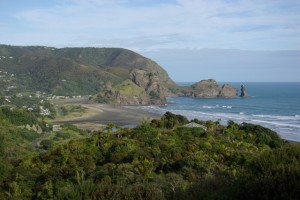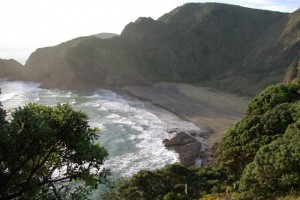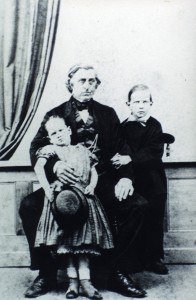White’s Beach is a small beach to the north of Piha. On the headland between North Piha and White’s Beach, the Te Waha point was the site of one of Piha’s pa. Today, this small headland, surrounded by steep cliffs, is the home to grey-faced petrels, which nest in the ground around the roots of pohutukawa.
White’s Beach is reached either by climbing the Laird Thomson Track which runs off Kohunui Bay at the end of North Piha, or by taking the Marawhara Walk (entrance off North Piha Road, opposite the North Piha Campers’ Club campground), which then joins the White’s Beach Track which climbs fairly relentlessly up to Anawhata Rd.
You then walk down a long steep concrete drive to end up above White’s Beach and then take the track down to the shore.
There are great views over much of this route back over Piha and then looking down into White’s Beach. White’s Beach is remote, has beautiful sand dunes, and you probably shouldn’t swim except in really calm conditions.
White’s Beach is named after Francis White, a blacksmith, whose son Francis negotiated the purchase of much of the West Coast land from Te Kawerau a Maki. In 1861 Francis gained a Crown Grant for 600 acres north of Piha. He was probably hoping to mill the kauri in the area, but that defeated many at Piha because of the difficulties in getting logs out.
Land at White’s Beach was purchased by Jim Rose from HA Mobbs in 1925 and he established a bach which could only be reached by crawling up the cliff at North Piha there being no road to Anawhata till the 1930s.
Jim’s daughter, Louise, married Ed Hillary and the Hillaries still have a bach there. Sir Ed did much of his fitness preparation by hiking around the trails on the Coast, and today there is a long Hillary Trail that commemorates this pioneering mountainclimber.
In the 1960s, Jim Rose and his neighbour Mr Laird Thomson, gave Te Waha Point to be added to the regional parkland.
If you are super-fit, you could continue on to Anawhata, but once again, there is a steep track down to the beach, which is testing for knees and calf muscles.





